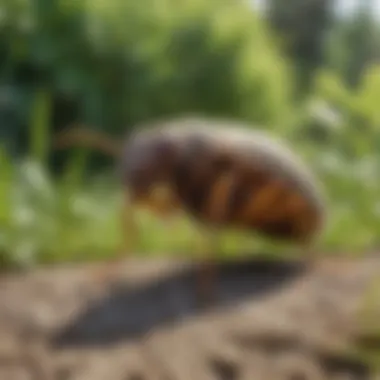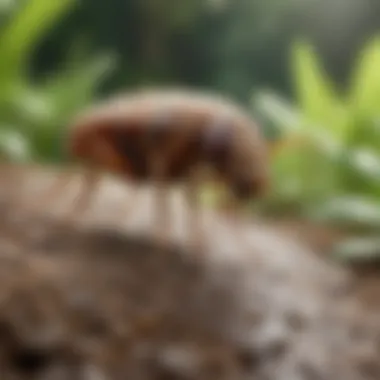Effective Strategies for Spraying Your Yard Against Fleas and Ticks


Intro
Fleas and ticks are small, yet formidable pests that can turn your yard into an undesirable environment. Homeowners often seek effective solutions to manage these nuisances. The process of spraying your yard for fleas and ticks involves understanding different factors that can affect both safety and efficacy. Knowing the right methods, treatments, and precautions can significantly impact the outcome. This guide aims to shed light on various aspects of yard treatment, providing practical information to help manage flea and tick populations, ensuring a safe environment for both humans and pets.
Animal Species Profile
Prelude to Fleas and Ticks
Fleas and ticks are parasitic insects that primarily affect mammals, including pets and humans. Fleas are small and jump around, while ticks are arachnids that latch onto hosts to feed on blood. Both these pests thrive in environments where hosts are readily available, making yards a prime target.
Physical Characteristics and Appearance
Fleas are typically dark brown and measure around 1/8 inch in length. Their body shape is flat, which allows them to navigate through fur and feathers easily. Ticks are larger, with adult ticks being about the size of a small pea. They are usually round and can change color as they engorge themselves on blood.
Natural Habitat and Distribution
Both fleas and ticks prefer warm, humid environments. They are commonly found in areas with tall grass, shrubs, and leaf litter. Fleas can also be associated with pets and pet bedding, while ticks are often found in wooded or grassy areas. Their distribution varies geographically, but they are widespread across the United States.
Behavior and Social Interactions
Fleas are solitary creatures that spend most of their life cycle on a single host. They are known for their jumping ability, allowing them to move quickly between hosts. Ticks, on the other hand, exhibit a behavior known as questing, where they wait on vegetation for a host to pass by. Both pests reproduce rapidly, creating significant infestations in short periods.
Treatment Options for Fleas and Ticks
When considering how to treat your yard, several options exist. Some of these include chemical sprays, natural treatments, and preventative measures. Each treatment has its own set of advantages and considerations.
Chemical Sprays
Chemical sprays are among the most common treatments. Products containing pyrethroids or neonicotinoids are effective at killing fleas and ticks. They are usually applied to the vegetation in your yard. However, caution is necessary as these chemicals can impact non-target species, including beneficial insects and aquatic life.
Natural Treatments
Natural treatments are becoming more popular among environmentally conscious homeowners. Diatomaceous earth and essential oils are effective alternatives that can deter fleas and ticks without harsh chemicals. However, while they may be safer, they can require more frequent applications.
Prevention Strategies
Preventing infestations is crucial. Regular lawn maintenance, such as mowing and trimming reduces potential habitats for these pests. Additionally, treating pets with veterinary-recommended flea and tick preventatives can minimize their presence in your yard.
Ecological Considerations
Using pesticides raises important ecological questions. While they can quickly reduce pest populations, their long-term use can harm local ecosystems and reduce biodiversity. It's essential to weigh the benefits of immediate control against the ecological implications of chemical treatments.
Effective yard management involves understanding both treatment options and their impacts.
Culmination
Spraying your yard for fleas and ticks can offer temporary relief from these pests. However, it is crucial to choose treatments carefully by understanding their impacts. Integrating preventive strategies is key in ensuring a long-term solution. This approach not only maintains the health of your yard but also safeguards the wellbeing of humans and pets alike.
Understanding Fleas and Ticks
Understanding the biology and behavior of fleas and ticks is essential when considering your yard treatment options. Recognizing their life cycles, habitats, and the effects they have on both pets and humans can provide valuable insights. This foundation equips homeowners with the insight needed to create effective strategies for control and prevention.
Life Cycle of Fleas
Fleas undergo a complex life cycle consisting of four stages: egg, larva, pupa, and adult. Eggs are laid by adult fleas in the fur of pets or on surfaces in the environment, often in shaded areas. Once laid, the eggs will hatch into larvae within a week. Larvae feed on organic debris, including flea feces, which is vital for their development.
The larvae then enter a pupal stage. This stage can last for several days to several months, depending on environmental conditions. When conditions are right, such as the presence of a host, the pupae emerge as adult fleas.
Key points about flea life cycle:
- Adaptability: Fleas can survive in various environments, making control challenging.
- Rapid reproduction: A single female flea can lay up to 50 eggs daily, leading to quick infestations if not addressed.
Life Cycle of Ticks


Ticks also have a life cycle composed of four stages: egg, larva, nymph, and adult. Female ticks lay thousands of eggs in a protective environment, such as leaf litter or soil. Upon hatching, the larvae emerge and must find a host to feed on, commonly attaching to small mammals.
After feeding, they grow into nymphs, which also require a blood meal. This stage can be particularly dangerous, as nymphs are often responsible for transmitting diseases due to their small size. Lastly, nymphs mature into adults, which can feed on larger mammals, including dogs and humans.
Key points about tick life cycle:
- Disease vectors: Ticks are known to transmit pathogens like Lyme disease and Rocky Mountain spotted fever.
- Host-seeking behavior: Ticks can remain dormant for a while but will actively search for a host when conditions are optimal.
Impact on Pets and Humans
The presence of fleas and ticks can have significant implications for both pets and humans. Fleas typically cause itching and discomfort in pets, leading to hair loss and skin irritations. In severe cases, a flea infestation can lead to anemia, particularly in young or frail animals.
Ticks pose even more severe risks due to their role as vectors for various diseases. For instance, humans can suffer from Lyme disease, while pets may be affected by conditions such as Ehrlichiosis. Both fleas and ticks can cause allergic reactions and other health issues.
Staying informed about the impact of these pests on health is crucial. Regular checks for fleas and ticks, along with timely treatments, can ensure your pets remain healthy and comfortable in their environments.
Awareness of signs and symptoms in pets is key to early detection and prevention.
The Necessity of Yard Treatment
Fleas and ticks present a significant challenge for pet owners and those who value outdoor spaces. Understanding the necessity of yard treatment is crucial for maintaining a safe and healthy environment. These pests not only affect the comfort of pets but pose risks to human health as well.
By treating your yard, you can prevent the establishment of flea and tick populations. Early intervention is key. A proactive approach helps in managing the issue effectively. This section highlights important elements that justify the need for yard treatment and examines the benefits that accompany this action.
Signs of Flea and Tick Infestation
Recognizing signs of flea and tick infestation is essential. Fleas are often small, brown, and hard to see against fur. Common signs include:
- Excessive scratching or biting by pets
- Flea dirt on pet fur, resembling tiny black specks
- Fleas jumping in the fur when disturbed
Ticks, on the other hand, can cling to fur or clothing. Look for:
- Visible ticks on pets or clothing
- Red, inflamed skin where ticks have attached
- Signs of tick bites, such as irritation or rashes
Being aware of these signs allows for timely action. If the issue is evident, taking steps to treat your yard becomes critical. Otherwise, infestations can grow beyond control, affecting pets and family alike.
Why Spraying is Important
Spraying your yard serves multiple important purposes. Firstly, it directly reduces the population of fleas and ticks. This not only protects pets but also reduces the risk of diseases transmitted to humans. Various illnesses can arise from these pests, like Lyme disease from ticks and allergic reactions from fleas.
Moreover, regular treatments can significantly lower the likelihood of reinfestation. It establishes a barrier that makes it difficult for new pests to take root. In addition to spraying, incorporating other yard management techniques can further enhance results. This include proper landscaping and maintaining a clean lawn.
In summary, both timely identification and the right treatments function together. This combined effort protects your home, family, and pets from the harmful effects of fleas and ticks.
"Proactive pest management is crucial to ensuring a safer living environment and a healthier lifestyle for you and your pets."
Types of Sprays for Yard Treatment
Yard treatment for fleas and ticks can be effective with the right type of spray. Understanding the different options available allows homeowners to make informed choices. Key elements include efficacy, safety, and environmental impact. By categorizing sprays into chemical and natural options, one can weigh their benefits and risks effectively.
Chemical Sprays
Chemical sprays are popular choices for treating yards because of their potent effectiveness in eliminating fleas and ticks quickly.
Types of Chemicals Used
Chemical sprays often contain synthetic insecticides like pyrethroids. These chemicals mimic natural compounds found in chrysanthemum flowers. The primary characteristic of these substances is their ability to disrupt the nervous systems of insects, leading to their quick demise. This makes chemical sprays a popular choice for homeowners who need rapid results.
However, there are unique features to consider. While some chemicals provide extended protection, others may require multiple applications. Additionally, the application of these chemicals can impact beneficial insects, which raises ecological concerns. Thus, understanding their behavior and effects is crucial.
Effectiveness and Risks
The effectiveness of chemical sprays is generally high, given their formulation to target pests directly. They can kill fleas and ticks on contact, making them beneficial for immediate infestations. However, this effectiveness comes with specific risks. Many chemical sprays can be harmful to pets if not used properly. Over-exposure can lead to negative health outcomes in both animals and humans. Furthermore, residue from sprays can persist in the environment, affecting local ecosystems. Homeowners need to balance the need for urgency with safety considerations.


Natural Sprays
Natural sprays are increasingly sought after as alternatives to chemical treatments, reflecting a growing desire for sustainable solutions.
Common Natural Ingredients
Common natural ingredients include essential oils like peppermint, rosemary, or cedarwood. These substances are derived from plants and often carry insect-repelling properties. A key features is their safety profile, making them a beneficial choice for gardens frequented by pets and children. These essential oils not only repel pests but also tend to be biodegradable, leaving minimal environmental footprint.
However, it's important to note the unique effectiveness of natural sprays. They may not be as potent as chemical alternatives, which leads to a varied efficacy. Homeowners using these treatments may find they need to apply them more frequently to achieve the same level of effectiveness against fleas and ticks.
Comparative Efficacy
The comparative efficacy of natural sprays often presents lower immediate effectiveness than chemical options. However, their potential to provide long-term protection should be acknowledged. This is particularly true in cases where chemical residues pose risks to the ecosystem. With their availability in natural marketplaces, some users view them as a safer, albeit slower solution.
In sum, choosing between chemical and natural sprays involves assessing both immediate needs for pest control and the long-term goals for yard health. Homeowners must intelligently navigate these options, weighing benefits against potential hazards. A thoughtful approach can lead to effective management of flea and tick populations while safeguarding the environment.
Application Techniques
Understanding how to effectively spray your yard for fleas and ticks is crucial for achieving the desired outcome. The right application techniques can enhance the effectiveness of treatments while ensuring the safety of pets, children, and the environment. Proper timing, application methods, and follow-up practices can significantly influence the success of yard treatments against these pests.
When to Spray
The timing of your spraying is vital. Ideal conditions for spraying typically occur in the early morning or late afternoon when temperatures are cooler, and wind speeds are low. This reduces drift and ensures more product lands where it is needed. Additionally, avoiding rain for at least 24 hours post-application is recommended. Rain can wash away treatments, making them less effective.
Seasonality also plays a major role. Fleas and ticks thrive in warm, humid environments. For many regions, applying treatments in late spring and early summer can help prevent infestations before they take hold. Regular monitoring of flea and tick activity in your area can provide insight into the best times to spray.
Important: Pay attention to local pest forecasts and your own observations. If you notice an uptick in flea or tick activity, it may warrant an immediate treatment.
How to Properly Apply Sprays
Proper application of sprays requires attention to detail. Here are several important steps:
- Choose the Right Equipment: A backpack sprayer or hose-end sprayer is often effective for larger yards. Ensure your equipment is clean and functioning properly to prevent uneven application.
- Follow Instructions: Always read the label on the product you are using. Proper dilution and application rate are crucial for effectiveness and safety.
- Cover All Areas: Focus on areas where your pets frequently roam, as well as shaded spots where fleas and ticks tend to hide. This includes areas under bushes, trees, and around flowerbeds.
- Uniform Coverage: Ensure that you achieve a thorough and even application across the treated area. Overlapping passes may be necessary to ensure no spots are missed.
- Protective Gear: When applying sprays, wearing gloves, long sleeves, and a mask can help protect you from exposure to chemicals.
- Observe Weather Conditions: Best to keep the sprayer steady and avoid windy days. Check the weather report before applying to ensure effectiveness.
- Post-Application Care: Keep pets and children away from treated areas until the product has dried completely, adhering to the recommended waiting periods on the label.
Following these guidelines will help maximize your efforts in treating your yard effectively against fleas and ticks while maintaining safety for loved ones.
Safety Considerations
Spraying your yard for fleas and ticks is a common method used by pet owners and homeowners to manage these pests. However, it necessitates careful consideration of safety aspects. The chemicals utilized in sprays can have varied impacts on pets, children, and the environment. Understanding these factors is crucial not only for effectiveness but also for overall safety.
Impact on Pets
Pets are often exposed to yard treatments, especially if they roam freely outdoors. It is imperative to understand the potential effects of these sprays on your animals. Many chemical-based treatments can be toxic to pets. For instance, ingredients like permethrin and pyrethroids, commonly found in flea and tick sprays, can lead to adverse reactions in animals. Symptoms may include drooling, lethargy, or even more severe health issues. Therefore, following product instructions closely is crucial.
Here are some safety practices for protecting pets:
- Ensure the product is specifically labeled safe for pets.
- Keep pets away from the treated areas until they are fully dry.
- Always read labels for specific pet safety guidelines.
- Consult with your veterinarian before using new chemical treatments.
Impact on Children
Children, being naturally curious, often play in areas treated with pesticides. This environment can pose a risk of exposure to harmful chemicals. KIds may come into contact with treated soil or grass, leading to ingestion or skin absorption of toxic substances. The ongoing exposure can result in health issues, ranging from mild irritation to more serious concerns.
To mitigate risks, consider these recommendations:
- Install barriers to limit access to treated areas.
- Use non-toxic, child-safe alternatives when possible.
- Educate children about the importance of safety in treated areas.
- Ensure that children wash their hands and clothes after play.
Environmental Concerns
The use of chemical sprays can lead to broader environmental issues. When chemicals enter the ecosystem, they affect beneficial insects and wildlife. Moreover, runoff from treated yards can contaminate water sources, harming aquatic life. Therefore, understanding the ecological implications of pesticide use is vital for any responsible homeowner.
Some considerations include:
- Opting for natural or organic sprays when feasible.
- Being aware of local wildlife habitats and their proximity to sprayed areas.
- Following the application instructions to reduce environmental impact.


A thoughtful approach to pest management balances effectiveness with safety for pets, children, and the environment.
Preventive Measures
Preventive measures are a critical aspect of managing flea and tick populations in your yard. By focusing on proactive strategies, homeowners can significantly reduce the likelihood of infestations and the associated risks to pets and humans. The importance of preventive measures lies in their capacity to create an unfavorable environment for fleas and ticks. Effective prevention not only protects your immediate living space, but it also helps in safeguarding the overall ecosystem. Fleas and ticks thrive in habitats that provide shelter, moisture, and ample food sources. Reducing these factors can minimize their presence.
Regular Lawn Maintenance
Regular lawn maintenance forms the foundation of effective flea and tick prevention. This includes practices like mowing the grass consistently, trimming overgrown shrubs, and keeping the yard free of debris. High grasses and dense foliage provide ideal hiding places for these pests. By maintaining a clean and well-manicured lawn, you can disrupt their life cycles.
Additionally, consider the following practices:
- Mow frequently: Keep the grass short to limit hiding spaces.
- Rake leaves: Piles of leaves can retain moisture and attract pests.
- Clear clutter: Remove any items like wood piles or old furniture that may harbor pests.
Investing time in lawn care not only improves aesthetics but also minimizes the risk of flea and tick infestations. Regular maintenance creates an environment that is less inviting to these insects.
Use of Barriers and Traps
Implementing physical barriers and traps is another important measure to control flea and tick populations. Fencing off certain areas can prevent wildlife from entering your yard, reducing the chances of fleas and ticks coming from external sources. Moreover, certain traps specifically designed for fleas and ticks can be strategically placed to monitor and capture pests before they proliferate.
Effective barriers and traps include:
- Fences: Install fences that prevent wild animals from entering your yard.
- Commercial traps: Utilize sticky traps that attract and capture fleas.
- Natural repellants: Consider using plants known for their repellent properties, such as marigolds and rosemary.
While barriers and traps may not fully eliminate the problem, they can be an effective complementary strategy when used alongside other preventive measures.
A multifaceted approach combining regular lawn maintenance with barriers and traps maximizes protection against flea and tick infestations in your yard.
Long-Term Solutions
Long-term solutions to managing fleas and ticks in your yard are essential for maintaining a healthy environment for both pets and humans. These methods are not just about immediate relief; they aim for sustainable management of pest populations over time. Effective long-term strategies ensure that fleas and ticks do not become a recurring problem, reducing the need for frequent chemical interventions. Moreover, they also promote a balanced ecosystem, which is crucial for sustaining local wildlife.
Integrated Pest Management
Integrated Pest Management (IPM) focuses on a holistic approach to pest control. It combines multiple strategies to prevent and manage flea and tick infestations effectively. An important aspect of IPM is the use of monitoring techniques. Homeowners must regularly inspect their yards for signs of fleas and ticks. This can include checking pets, outdoor furniture, and shaded areas where these pests tend to reside.
A few key components of Integrated Pest Management include:
- Biological control: This involves introducing natural predators of fleas and ticks into the environment. For instance, certain nematodes can be very effective in controlling flea larvae.
- Cultural practices: Maintaining a healthy yard is vital. Regular mowing, removing debris, and controlling humidity in your yard can greatly reduce conducive conditions for fleas and ticks.
- Chemical control: While this article discusses long-term solutions, IPM does not completely eliminate chemical use. Instead, it promotes targeted applications when necessary, minimizing risks to non-target species and the environment.
By employing Integrated Pest Management, homeowners can achieve a more sustainable way to cope with flea and tick problems.
Collaborating with Pest Control Professionals
Working with pest control professionals may also enhance long-term flea and tick management. Professionals have expertise in assessing infestations and suggesting appropriate treatments. They can provide tailored solutions that combine chemical and non-chemical methods, aligning perfectly with your yard’s specific conditions.
When collaborating with pest control experts, consider these factors:
- Initial Assessment: They will examine your property for potential flea and tick habitats, giving you insight into high-risk areas.
- Customized Plans: Based on their assessments, professionals can create specific pest management plans that fit your needs.
- Education: A good pest control service informs homeowners about preventive measures that they can implement. This might include recommendations for lawn care, pet treatments, and habitat modifications.
Ultimately, combining your efforts with a professional service can lead to much better long-term results. The expertise and advanced techniques they offer often mitigate the risk of reinfestation while you focus on maintaining a safe yard for your loved ones.
Investing time and resources in long-term strategies for flea and tick management can significantly reduce future outbreaks, ensuring a healthier living space.
Culmination
The topic of managing fleas and ticks effectively in your yard cannot be overstated. It represents not just a matter of pest control, but also a significant concern for the health and safety of pets and humans alike. This article has explored various methods for treating your yard, emphasizing the critical balance between efficacy and safety. Utilizing sprays, whether chemical or natural, has its benefits and drawbacks, but it's essential to approach these solutions with care and informed judgment.
Summarizing Best Practices
As we summarize best practices, several key strategies emerge as essential tools in managing fleas and ticks. Consider the following:
- Regular Yard Maintenance: Mowing the lawn, trimming bushes, and removing leaf debris reduces potential hiding spots for fleas and ticks. This vigilance helps keep populations in check and lessens the need for sprays.
- Spray Application: When applying sprays, timing is important. It's best to treat when the weather is calm to avoid drift, and late afternoon or evening applications reduce exposure to beneficial pollinators.
- Adopting Integrated Pest Management (IPM): This holistic approach combines various treatment options. IPM focuses not just on eliminating pests but also on preventing infestations through habitat management and biological controls.
- Choosing the Right Products: Selecting the right spray—be it chemical or natural—is crucial. Understanding the difference in their mechanisms of action and potential impact on the environment helps in making informed choices.
By adhering to these best practices, homeowners can effectively manage fleas and ticks while safeguarding their ecosystem and the health of their loved ones.
Final Thoughts on Flea and Tick Management
In closing, managing fleas and ticks is an ongoing commitment. It demands not just a reaction to infestations but a proactive approach to prevention and safety. Awareness and education about the life cycles of these pests, the signs of infestations, and effective treatment options make all the difference.
Ultimately, collaboration with pest control professionals can offer deeper insights and tailored strategies for individual yards. Flea and tick management is not merely a one-time task but a regular aspect of yard maintenance. Adopting a comprehensive approach will yield the most favorable outcomes, leading to a healthier environment for both pets and residents. Therefore, educated choices play a vital role in ensuring the efficacy of any method employed, while maintaining a commitment to safety across all measures taken.







